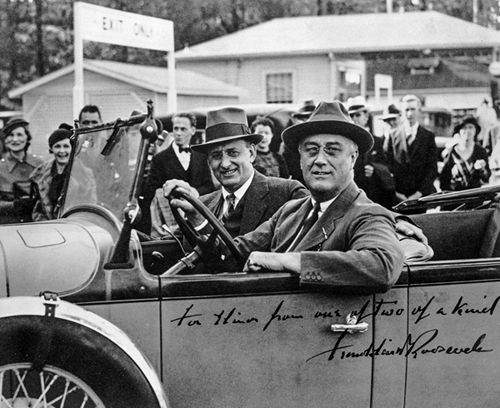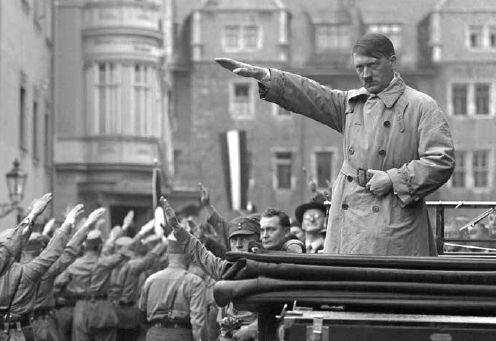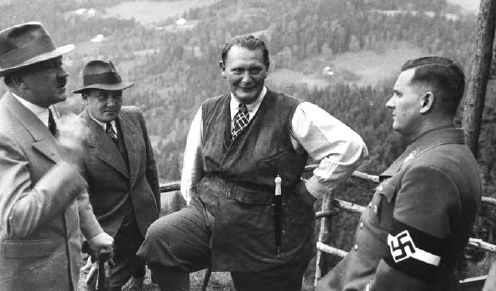Chasing Gold: The Incredible Story of How the Nazis Stole Europe's Bullion (80 page)
Read Chasing Gold: The Incredible Story of How the Nazis Stole Europe's Bullion Online
Authors: George M. Taber

BOOK: Chasing Gold: The Incredible Story of How the Nazis Stole Europe's Bullion
13.4Mb size Format: txt, pdf, ePub
.
Wolfe, Martin.
The Development of Nazi Monetary Policy
. The Journal of Economic History. Vol. 15. No. 4, December 1955.
Sivertsen, Svien Carl.
The Day of Destiny in Molde, April 1940
. Norsk Tidsskrift for Skøvesen, 2000.
Ziegler, Dieter.
A Regulated Market Economy: New Perspectives on the Nature of the Economic Order of the Third Reich 1933-1939,
Hartmunt Berghoff, Business in the Age of Extremes, pp. 139-152.
INTERNET SITES
Weixelbaum, Jason. The Contradiction of Neutrality and International Finance:
jasonweixelbaum.wordpress.com
Proceedings and Documents of the United Nations Monetary and Financial Conference. Bretton Woods, New Hampshire, July 10-22, 1944
: fraser.stlouisfed.org
Bank for International Settlements, Annual Reports 1935-1945
: bis.org/publ/arpdf/archive/index.htm
Vogier, Robert. The Swiss National Bank’s Gold Transactions with the German Reichsbank from 1939 to 1945
: snb.com
U.S. Army, Third U.S. Army. After Action Report, Third U.S. Army
: paperlessarchives.com/wwii_third_army_after_action_r.htmlwww.anac-fr.com/2gm/ 2gm_19.htm
Christopher Columbus Reports on Voyages. Fordham University, Internet Medieval Sourcebook
: fordham.edu/halsall/sbook.asp.
Timothy Green study Central Bank Gold Reserves Since 1945
: scribd.com/doc/119942259/CentralBankGoldReserves-Since-1845
Papal Encyclicals Online, Pius XI, Dilectissima Nobis
: papalencyclicals.net
The American Presidency Project, University of California Santa Barbara
: www.presidency.ucsb.edu
German History Documents
: germanhistorydocs.ghi-dc.org
SS Laurentic
: laurentic.com and naval-history.net/OWShips-WW1-08Laurentic.htm
wikipedia.org/wiki/SS_Laurentic_(1908)
Winston Churchill Speeches
: winstonchurchill.org
Biographical Dictionary of Italians
: treccani.itencyclopedia
Trilateral Commission for the Restitution of Monetary Gold, Final Report
: state.gov/s/l/65668.htm
Paris Conference on Reparations, November and December 1945, Final Report
: cvce.eu/education/unit-content/-/unit/en/55c09dcc-a9f245e9-b240- eaef64452cae/cf8a7bab-3e2b-4406-a7fb-2a5757198da3/Resources# 5c0dfcd9-2af2-431b-8cbf-e8e288aef30e_en&overlay
Krähling, Katrin Isabel.
Das Devisenschutzkommando Belgien, 1940-1944:
kops.ub.uni-konstanz.de/bitstream/handle/urn:nbn:de:bsz:352-opus-18753/Das_Devisenschutzkommando_Belgien_1940_1944.pdf?sequence=1
ARCHIVES
Banque de France, Paris (Bank of France)
Banque nationale de Belgique/Nationale Bank van België (National Bank of Belgium)
Bundesarchiv, Berlin and Freiburg (German Federal Archives)
William J. Clinton Presidential Library, Little Rock, AK
Institut für Zeitgeschichte (Institute of Contemporary History), Munich
New York Federal Reserve, New York, NY
Józef Piłsudski Institute of America, New York, NY
Franklin D. Roosevelt Presidential Library, Hyde Park, NY
Harry S. Truman Presidential Library, Independence, MO
ACKNOWLEDGMENTS
I have been for years interested in the story of central bank gold in World War II, and this book has been a longtime work of love. It was also a massive undertaking because it involved so many countries and different foreign languages. One dispirited day I did a quick calculation and figured that I had to research more than two dozen countries with nearly that many languages. I can work in English, French, and German, but not in Norwegian, Albanian, Portuguese, Dutch, Russian, and many others.
The first thank-you goes to Curt Prendergast, my first boss at
Time
magazine, who as the dedication explains, tipped me off to the topic nearly fifty years ago.
Time
magazine, who as the dedication explains, tipped me off to the topic nearly fifty years ago.
Fortunately, I was able to put together a team of people from all around Europe who helped me in a variety of ways. Some tracked down documents; others helped me with translations. Others did translations of reports and even whole books. They all helped me understand their country’s wartime history. They also read the chapter about their nation and made helpful suggestions and corrections. The book could not have been done without them. The list starts with two Germans, Dirk Lau in Hamburg and Elisabeth Kaiser in Brussels. They were both patient with many questions and guided me around the shoals of German history. Elisabeth found some crucial books and offered wise counsel. Dirk and I had Skype phone calls to discuss things, and he also did research at the Berlin archives. Both sometimes double-checked my German translations.
They, though, were only the beginning. The list begins with winter neighbors in Vero Beach, such as Jurich Dorawa in Vero Beach, FL, who helped with Polish documents. Hermann Schnabl and Evelyn Kopke-Gripenberg did the same with German, and Boyd Fellows improved the quality of the photographs. Jacek Szafran helped with both Polish translations and his knowledge of his country’s history. Jan Emsbro found Norwegian material, and Keith Lewis guided me through maritime terms. Mary Ann Sorrentino translated a crucial Italian book. Tihmir Lerner helped from Croatia. Mari H. Rowland translated the long report written in 1940 by the leader of the Norwegian gold evacuation. Per Arnt Harnes, author of
Gulltransporten
, read the Norwegian chapter. Bo Lidegaard in Denmark translated a crucial section of his book
Kampen om Danmark 1933-1945
. Anders Bergnas, a graduate school friend, helped me in Sweden. When I was in Belgium, Hermann Van der Wee and Walter Pluym, who have both written books about their country’s gold saga, were very generous with their time and pointed me to key documents. Van der Wee’s book, which was done with his wife Monique Verbreyt, is
A Small Nation
. Pluym’s work, written with his brother Jan, is
Goud op Drift
in the Dutch edition and
Or à la Dérive
in the French one.
Gulltransporten
, read the Norwegian chapter. Bo Lidegaard in Denmark translated a crucial section of his book
Kampen om Danmark 1933-1945
. Anders Bergnas, a graduate school friend, helped me in Sweden. When I was in Belgium, Hermann Van der Wee and Walter Pluym, who have both written books about their country’s gold saga, were very generous with their time and pointed me to key documents. Van der Wee’s book, which was done with his wife Monique Verbreyt, is
A Small Nation
. Pluym’s work, written with his brother Jan, is
Goud op Drift
in the Dutch edition and
Or à la Dérive
in the French one.
Officials at the Banque de France were extremely helpful both before and after the week I did research in Paris. Didier Bruneel, the director of the excellent publication
Cahiers anecdotiques de la Banque de France
and the special counselor to the bank’s president, helped in many ways. He provided the first solid information about how the Soviet Union saved its gold, and also allowed me to use photographs he had collected for his own book
Les Secrets de l’Or
. When I arrived in Paris, Arnaud Manas, the head of the archives at the French National Bank, had just finished the defense of his doctoral thesis on the Vichy government’s gold policy. He gave me a copy of it and also helped me find my way through his archives.
Cahiers anecdotiques de la Banque de France
and the special counselor to the bank’s president, helped in many ways. He provided the first solid information about how the Soviet Union saved its gold, and also allowed me to use photographs he had collected for his own book
Les Secrets de l’Or
. When I arrived in Paris, Arnaud Manas, the head of the archives at the French National Bank, had just finished the defense of his doctoral thesis on the Vichy government’s gold policy. He gave me a copy of it and also helped me find my way through his archives.
Paul Dostert in Luxembourg has done work on his own country’s gold during the war, and he gave him time both to explain what happened and point me to the archives. We also had a pleasant lunch at an outdoor café.
A small team helped in Holland. Alexander Nieuwenhuis put together an excellent program that got me to the right people. Ronald Dijkstra, who was just finishing his own book on the Dutch story, spent a day walking around Rotterdam, retracing the steps of the soldiers who carried gold to a boat that hit a mine and sank and then visiting the site. We also visited the ship museum near the Hook of Holland, where officials told us more about the ship. Gerard Aalders, who has written an excellent book in Dutch about his country’s gold, answered all my questions over glasses of Dutch beer. Daphne Dupont-Nivet translated his book for me.
Svetlana Chervonnaya in Moscow deserves all the credit for finding the right Russian documents and then translating them. It would have been impossible to do the Soviet chapter without her. She was also very helpful in unraveling the story of the shipment of Spanish gold to Moscow in 1936.
In Britain, Robert Hart, who was a fellow journalist many years ago in Bonn, worked with me for a week combing the British National Archives outside London for cabinet records and ship logs.
Central bankers have a reputation for being stuffy, but officials at banks from Portugal to Turkey, with many more in between, were generous in providing help in uncovering their stories. Most of the communication was done over the Internet. I would like to thank in particular Jenni Hellström at the Bank of Finland, who sent me the chapter from a history of her bank that dealt in detail with the Finnish story.
Officials in national and central bank archives are the unsung people in the background. They helped find the right documents or photographs. Joseph M. Komljenovich, Julie Sanger, and Marja Vitti at the New York Federal Reserve opened up their collections during two long visits. Officials at the Franklin D. Roosevelt Library and the Harry S. Truman Library were helpful when I visited their archives. The William J. Clinton Library provided documents over the Internet. The staffs of the U.S. National Archives in College Park Maryland, the Banque de France, the Bundesarchiv in Berlin and Freiburg, the Bayerische Hauptstaatsarchiv in Munich, and at the British National Archives were particularly valuable. I made four long visits to the U.S. National Archives in College Park, MD, and Margaret Shannon and Candace Clifford also did work for me there. Peter Voskamp tracked down some crucial material at the newspaper collection of the Library of Congress in Washington. The staff at the Thomas J. Dodd Research Center at the University of Connecticut opened its wonderful collection of Nuremberg Trial documents. Andy Hollinger of the United States Holocaust Memorial Museum in Washington provided many useful photos from its collection.
Librarians also were essential aides. I thank those at Brown University, University of Rhode Island, Stanford University, the New York Public Library, Princeton University, University of Connecticut, Harvard Business School, Vero Beach, and the Block Island Free Library.
The most important assistance of all came from my wife Jean, who over several years read and edited many early versions of chapters, and from our daughter Lara, who diagnosed computer problems and also created the maps that accompany most chapters and designed the book’s photo pages. Both Jean and Lara were always there for me.
Special thanks to Jennifer McCartney for very carefully proofreading the manuscript.
I would also like to give special thanks to Harvey Klinger, my agent now for five books, and to Jessica Case and all the people at Pegasus Books.
ILLUSTRATIONS

Franklin D. Roosevelt in 1934 wrote a personal dedication to Henry Morgenthau, Jr., his close friend and partner in power: “For Henry from one of two of a kind.”
Courtesy of the Franklin D. Roosevelt Photo Collection, Morgenthau Folder
.
Courtesy of the Franklin D. Roosevelt Photo Collection, Morgenthau Folder
.

In Munich in the early days of his rise to power, Hitler returns the Nazi
Sieg Heil
salute to members of his paramilitary units. They had a hypnotic dedication to their
Führer. Courtesy of the Bundesarchiv Berlin Photo Collection
.
Sieg Heil
salute to members of his paramilitary units. They had a hypnotic dedication to their
Führer. Courtesy of the Bundesarchiv Berlin Photo Collection
.

Other books
By CLARE LONDON by NOVELS
Delirious by Suzannah Daniels
Dukes to the Left of Me, Princes to the Right by Kieran Kramer
Ampliacion del campo de batalla by Michel Houellebecq
Passing as Elias by Kate Bloomfield
Do Us Part (The Dumont Diaries (#4)) by Torre, Alessandra
Paint It Black by Michelle Perry
Getting Close to the Omega by Lisa Oliver
Touch of Darkness by C. T. Adams, Cathy Clamp
The Dragon Queens (The Mystique Trilogy) by Traci Harding